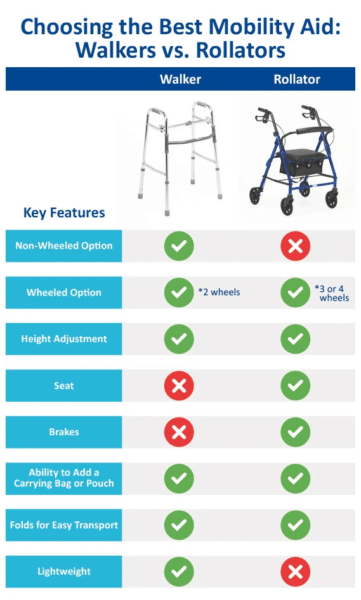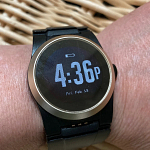Understanding the Need for Mobility Aids in the Elderly
The process of aging often brings about a variety of mobility issues among the elderly, such as muscle weakness, balance disorders, and arthritis. According to the Centers for Disease Control and Prevention, one in four U.S. adults have some type of disability, with mobility being the most common.

As people age, maintaining independence for as long as possible becomes increasingly important. Safety, however, should never be compromised. Mobility aids play a crucial role in balancing the two, providing the means to move around independently while minimizing the risk of falls and injuries.
The Role of Mobility Aids in Enhancing Quality of Life
Mobility aids such as canes, walkers, wheelchairs, and scooters, provide an invaluable service to seniors. They enhance quality of life by promoting autonomy and increasing participation in social activities. A study published in the Journal of Aging and Health found that using mobility aids can help reduce feelings of isolation and depression in the elderly.
Understanding Different Types of Mobility Aids and Devices
For individuals experiencing mobility difficulties, there is a wide range of assistive devices designed to enhance independence and quality of life. These devices range from simple walking sticks to complex electric scooters, each with unique features tailored to specific needs.
Walking Sticks
Walking sticks offer balance and stability to those with mild mobility impairments. They are lightweight, inexpensive, and suitable for individuals recovering from minor injuries or surgeries, and seniors with slight balance issues.

Walkers
Walkers provide more stability than walking sticks and are best for those with moderate mobility issues. They allow weight redistribution, reducing lower limb load. Studies show they can significantly reduce fall risk in the elderly.
Wheelchairs
Wheelchairs cater to individuals with significant mobility restrictions. They come in manual and electric models, with the latter offering increased independence for users with limited upper body strength.
Scooters
Electric scooters are ideal for people seeking to maintain an active lifestyle despite mobility limitations. These devices offer a higher speed and range than wheelchairs, making them suitable for outdoor use and long distances.

Key Factors to Evaluate When Selectifying Mobility Aids
When choosing mobility aids for seniors, it’s critical to consider several key factors to ensure the device meets their specific requirements. The overall goal is to enhance their safety and independence.
-
- Evaluating Specific Needs and Mobility Level: Prioritize understanding the seniors’ specific needs and the level of their mobility. Whether it’s a walking aid or a device for more severe mobility challenges, the aid should match the senior’s physical abilities and medical conditions.
-
- Comfort, Ease of Use, and Adaptability: The ideal mobility aid is comfortable, easy to use, and fits seamlessly into the senior’s lifestyle. It should not require excessive energy or cause discomfort during use.
-
-
- Home Environment and Required Modifications: Consider the senior’s living environment. Will the aid fit through doorways? Can it navigate the home terrain? Sometimes, modifications to the home are necessary to accommodate the mobility aid.
-
Why Professional Guidance and Assessment Matters
When it comes to choosing mobility aids for the elderly, professional consultation plays a crucial role. Healthcare professionals are equipped with the necessary expertise to understand the specific needs of your loved one, helping in the selection of the most suitable mobility aid.

The Role of Occupational Therapists
Occupational therapists are integral in assessing mobility needs. They can recommend aids such as walkers and wheelchairs based on their comprehensive evaluation of an individual’s physical condition and daily living activities.
Understanding Professional Mobility Assessment
A professional mobility assessment is a step-by-step process aimed at identifying the mobility requirements of an individual. It involves a thorough evaluation of physical capabilities, daily routine, and environmental factors. This evaluation informs the recommendation of appropriate mobility aids to improve the individual’s quality of life.
Financial Considerations and Insurance Coverage for Mobility Aids
Choosing the right mobility aid is a critical step in ensuring safety for the elderly, but it is equally important to consider the financial aspect. The cost of various mobility aids such as walkers, wheelchairs, and scooters can vary significantly based on their features and functionality.
Insurance coverage plays a pivotal role in managing these costs. Many insurance providers, including Medicare and Medicaid, often provide assistance, covering a portion of the cost of mobility aids.

Exploring Other Financial Assistance Programs and Resources
Don’t overlook other potential sources of financial assistance. Various state-based programs, non-profit organizations, and grants can help offset costs. Thorough research and consulting with a healthcare professional or financial advisor can open doors to numerous resources that can make mobility aids more affordable.
Safety Features in Mobility Aids
When it comes to selecting mobility aids, safety must be paramount. Key elements to look for include stability, non-slip grips, and brakes. These features provide crucial support and control, significantly reducing the risk of falls or injuries. For instance, studies highlight the importance of stability in mobility aids, emphasizing its role in preventing accidents.
Adjustability and Durability in Mobility Aids
Another pivotal aspect to consider is adjustability. This ensures the device can be tailored to the user’s specific needs, offering comfort alongside security. Furthermore, the weight capacity and construction of the device should align with the user’s physique. A report from the CDC underlines the importance of selecting mobility aids with an appropriate weight capacity to ensure safety.
Choosing the Right Mobility Aid
Lastly, the selection of the mobility aid should be determined by the user’s needs, physical capability, and the aid’s safety features. By combining these factors, one can select the ideal mobility device that ensures safety and enhances mobility.
Training and Adaptation Period: The Crucial First Steps in Mobility Aid Usage
The importance of proper training when using mobility aids cannot be overstated. It’s the first line of defense in preventing injuries in elderly individuals. Training provides the user with the knowledge and confidence to navigate their environment safely, reducing the likelihood of falls and other accidents.

Physical therapists play a pivotal role in this process. Their expertise in biomechanics and body movements enables them to teach safe and effective use of mobility aids. They tailor the training based on the individual’s unique physical capabilities and needs, making the transition smoother and more efficient.
The adaptation period to a new mobility device can pose some challenges. It’s a time of adjustment, relearning, and often, frustration. Understanding this phase is key to managing expectations and facilitating a successful transition. Patience, practice, and the right support can make this journey significantly less daunting.
Choosing the Right Mobility Aids and Devices: Ensuring Elderly Safety
When selecting mobility aids and devices, considering the user’s comfort, physical condition, and the environment they will be used in is vital. Each device comes with its own set of benefits and potential challenges. Therefore, it’s essential to make an informed choice. To aid in this decision, consulting with a licensed physical therapist is recommended.

Maintenance and Regular Check-Up of Mobility Aids: Ensuring Safety and Longevity
Proper maintenance and regular check-ups of mobility aids are instrumental to ensure safety and extend the lifespan of these devices. According to the study conducted by the National Center for Biotechnology Information, well-maintained mobility aids reduce the risk of accidents and provide reliable support for the elderly.

Effective Upkeep Strategies for Mobility Aids
Simple upkeep practices, like cleaning and lubricating, can significantly enhance the performance and durability of mobility aids. However, don’t hesitate to seek professional help when the device shows signs of wear and tear or malfunctions. Experts can accurately diagnose and fix the issues, saving you from unnecessary risks and costs.
Reassessing Needs through Regular Check-Ups
Regular check-ups are not just about maintaining the device but also about reassessing the user’s needs. As the physical conditions of the elderly may change, adjustments might be necessary for the mobility aids. Professional assessments will ensure that the device continues to offer optimal support and safety.
.





